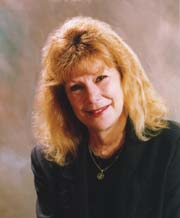Cross Creek, Florida--"Cross
Creek is a bend in a country road, by land, and the flowing of Lachloosa
Lake into Orange Lake, by water. We are four miles west of the small
village of Island Grove, nine miles east of a turpentine still, and
on the other sides we do not count distance at all, for the two lakes
and the broad marshes create an infinite space between us and the
horizon." -- Marjorie Kinnan Rawlings
Rawlings House is a Visit
to a Past Era
By Patricia Lieb
And so goes the story of Cross
Creek by Marjorie Kinnan Rawlings. It is an awesome feeling that makes
your flesh tremble. Actually, visiting the home of Marjorie Rawlings
is enough to make a writer want to sit down at the table on the verandah
at the old manual typewriter and start pounding out a story about a
deer flashing by, its white tail leaving a plot strong enough for an
entire novel.
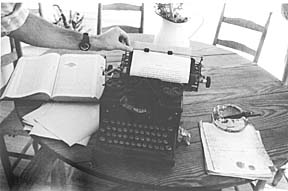
It is easy to see why Rawlings
loved the small, peaceful town of Cross Creek and the wildlife paradise
in the rich Florida hammocks. This is the perfect setting for a story
of a way of life now gone almost everywhere, even in the back areas
in such out-of-the way places as this.
Left to the University of Florida after Rawlings died in 1953, the
Rawlings homesite is surrounded by marsh land and hammock, all being
returned to its natural habitation.
Visitors to Cross Creek find the Rawlings home, still in a remote
setting, quite intriguing. To Rawlings, Cross Creek was perfect for
her writings. She wrote 10 successful books during the years she lived
here - an area most people from a sophisticated city lifestyle like
she had left, would consider wilderness.
But for Rawlings, this place was bliss. She wrote: "Enchantment
lies in different things for each of us. For me, it is in this: to step
out of the bright sunlight into the shade of orange trees; to walk under
the arched canopy of their jade-like leaves; to see the long aisles
of lichened trunks stretch ahead in a geometric rhythm; to feel the
mystery of a seclusion that yet has shafts of light striking through
it. This is the essence of an ancient and secret magic."
It was writing about people in this backwoods country that made Rawlings'
characters immortal. After writing a dozen rejected gothic novels, Max
Perkins, Rawlings' editor, told her the letters she wrote about the
people at Cross Creek were more interesting than her books.
Rawlings' newly found life here seeped into her blood. She developed
characteristics of people she met into characters for stories that
will remain in bookcases as long as society itself remains intact.
Rawlings' first novel set at Cross Creek, "Jacob's Ladder,"
was published by the University of Miami Press in 1931. The most popular
of her ten Cross Creek books was "The Yearling," which received
the Pulitzer Prize in fiction in 1939.
Her life at Cross Creek started when Marjorie and Charles, her newspaper-reporter
husband, paid $14,000 for 72 acres of land and moved from Rochester,
N.Y., to Cross Creek in 1928. The place was perfect for her, but for
Charles, it was too far removed. The only thing he cared about at Cross
Creek was that he did not have to shovel snow. That was not reason enough
to keep him in this wilderness land. He soon left Marjorie and went
back north, according to information from the Florida Department of
Natural Resources (DNR).
For Rawlings, however, Cross Creek and the people living here became
a part of her. She worked hard trying to keep the orange groves producing.
She learned to hunt for alligators and cook fancy country meals to
serve to guests.
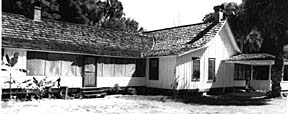
On the front verandah, surrounded
by books on one side and screened windows on the other, Rawlings spent
many hours at the typewriter while watching redbirds play in the birdbath
and eat sunflower seeds from the basket she filled and kept hanging
from a front yard tree. Such a basket still hangs in the same fashion
today and redbirds are still seen feasting there.
Walking across the original floors in the "cracker" farmhouse
with its four fireplaces to take the chill off winter nights and open
porches, screened windows and doors to take advantages of cool breezes,
one can feel Rawlings' inspiration bustling.
The eight-room house, built of cypress and heart pine, is of an unusual
styling today. But this design was popular in days before central
air-conditioning. It is believed the house is made of three small
houses put together.
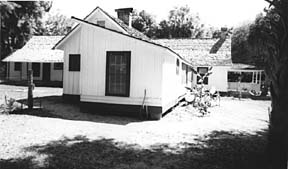
The front verandah, an
added edition to the house built in 1894, joins the living room, which
rambles on to another small room often used by Rawlings as a spare
bedroom. From here, visitors enter a bathroom -- the first indoor
bathroom in this part of the country -- which leads into another small
bedroom.
To enter Rawlings' bedroom, it is necessary to leave the main part
of the house, go out on the back porch, and enter the room through
an exterior entry. An entry from a front porch also leads into Rawlings'
bedroom. This room, added after the initial house was built, has its
own bathroom. When Rawlings would have house guests, she often gave
up her bedroom to them.

The kitchen and dining room
areas are connected to the rest of the house by a long screened-in breezeway.
Cracker houses, such as this, were common because they adapted to local
climate. In summer, open porches and windows allowed cross-ventilation
and the separation of the kitchen area from the rest of the house was
a way to keep the living and sleeping quarters from getting so hot on
sizzling summer nights. On a screened porch off the kitchen sits an
icebox which, when Rawlings lived here, was filled with ice twice weekly
-- that is if the ice-truck showed up that often.
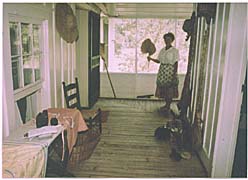
The wooden stove where Rawlings
baked her famous "Utterly Deadly Southern Pecan Pie" from
her own recipe, appears ready to fill with kindling and fire up.
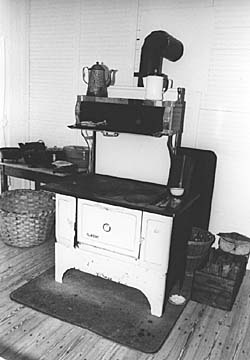
Rawlings entertained often
in her dining room. Her neighbors called her "Miss Uppity"
because she served catfish and hush puppies on fancy China.
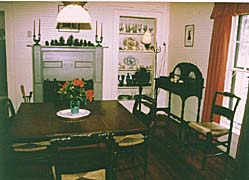
She was remembered, however,
by her neighbors as being very generous. The only person around these
parts with a car, she often gave rides to her neighbors.
The furnishings throughout the house were brought from Rochester by
steamboat. Bathroom floors still have the original Sears-and-Roebuck
linoleum.
As all furnishings in the Rawlings house, the liquor cabinet has a story
of its own. After running out of the supply of booze brought with her
from New York, Rawlings found she could purchase moonshine from some
local folks. She made an effort to keep the cabinets well filled for
whenever the occasion called for a nip.
Gee-chee, Rawlings maid, got to sipping at the stash. And when Rawlings
noticed the contents going down, Gee-chee told her that unlike alcohol
purchased in the north, moonshine evaporated.
After being alone for seven years, Rawlings married Norton Baskin
in 1941. A business man, Baskin stayed at Cross Creek with Rawlings
on the weekends and worked through the week in St. Augustine.
When Rawlings died of a brain hemorrhage in 1953 at age 57, she left
her property to the University of Florida. The university turned eight
acres, which includes the Rawlings home, over to the state to site
as a historical marker. The Marjorie Kinnan Rawlings State Historic
Site has been officially listed on the National Register of Historic
Sites since 1970. Eight acres of the site are managed by the Florida
Department of Natural Resources. The remaining 60 acres of the original
homestead are managed by Alachua County Parks and the University of
Florida Foundation. The university is allowing the property to return
to its natural state.
Yes. It is awesome. Casting eyes upon this natural piece of Florida,
watching various types of birds play freely in the trees, opening
your ears to the chats of crickets from the unspoiled hammock -- unable
to grasp all that is here. The ending to Rawlings' Cross Creek comes
loud and clear across the marsh lands and through the blowing pines:
"It seems to me that the earth may be borrowed but not bought.
It may be used but not owned. It gives itself in response to love and
tending, offers its seasonal flowering and fruiting. But we are tenants
and not possessors, lovers and not masters.
Cross Creek belongs to the wind and the rain, to the sun and the seasons,
to the cosmic secrecy of seed, and beyond all, to time."
In 1990, volunteers raised a replica of the barn once owned by Rawlings.
The new building made of the same sort of rough-cut pine as the original,
which fell apart and burned in the early 1960s, is located where the
initial barn stood 100 feet from the house.
Prior to the 1983 movie Cross Creek, visitors to Rawlings' home were
inclined to be devoted readers of her books. After the movie starring
Mary Steenburgen came out, visitors to the home almost tripled, according
to DNR information.
As tours of the house are nearly always full, visitors are encouraged
to see the barn and grounds, which remain a working farm with chickens,
orange trees and a garden of the same type vegetables once grown by
Rawlings.
Marjorie Kinnan Rawlings State Historic Site is located near Micanopy,
between Ocala and Gainesville just off U.S. 301. The house is accessible
to the handicapped by portable wheelchair ramp available upon request.
For more information,contact Marjorie Kinnan Rawlings State Historic
Site, Route 3, Box 92, Hawthorne, Florida, 32640.
|



